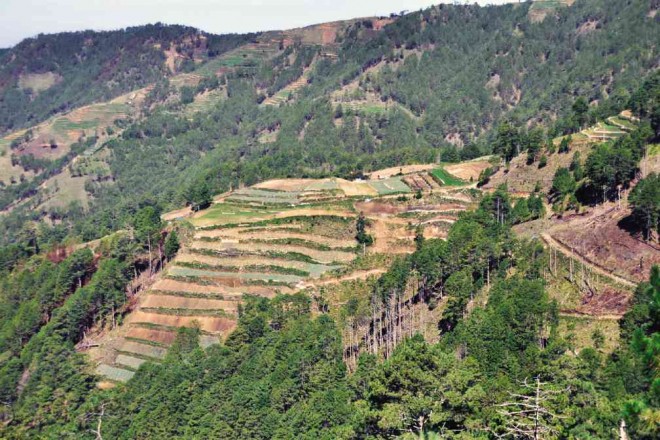Gov’t projects hurting Mt. Pulag

AS IF getting a bad haircut, a section of Mt. Pulag has been leveled to give way to vegetable farms and other projects supposedly for indigenous peoples but which have done more harm than good to the mountain. PHOTO COURTESY OF PIA CORDILLERA
BAGUIO CITY, Philippines—Government programs aimed at improving the lives of indigenous communities near Mt. Pulag in Benguet province are inadvertently paving the way for the destruction of one of the country’s remaining ecological havens, the park administrator said last week.
A tourist road leading to the mountain peak, agrarian support programs for vegetable growers and even health facilities built near the park have sent the wrong signals to settlements there that they can expand their farms into the most critical sections of the Mt. Pulag ecosystem, said Emerita Tamiray, superintendent of the Mt. Pulag National Park and Forest Reserve.
Many agencies implement these programs without assessing their overall impact on Mt. Pulag’s forest cover, which is home to endangered plants and animals, said Tamiray when she addressed the May 29 session of the Cordillera Regional Law Enforcement Coordinating Council (RLECC).
A government task force last week discovered that kaingin (slash-and-burn farming) operations had cleared up to 10 hectares of forest in Barangay (village) Ekip in Bokod town, an area also being claimed by clans in Kabayan town as their ancestral land.
Tamiray showed pictures of a road leading to Ekip. At the start of the year, the Department of Public Works and Highways was tasked with building or improving farm-to-market roads through settlements in the park, which enable illegal loggers and pocket miners to poach the mountain and the nearby Upper Agno River watershed, Tamiray said.
Article continues after this advertisementLast year, RLECC investigated park intrusions in the same area, which were attributed to a Kabayan landowner.
Article continues after this advertisementA similar problem was reported in Mt. Cabuyao, a watershed area behind Mt. Sto. Tomas in Baguio City, which may have contaminated some of the city’s water sources, said Chief Supt. Isagani Nerez, Cordillera regional police director and RLECC chair.
Paquito Moreno, Department of Environment and Natural Resources (DENR) Cordillera regional director, said vegetable gardens have displaced trees in Mt. Cabuyao and a road project leading to an ecopark was started without permits or an environmental compliance certificate, until it was stopped by the DENR last week.
Mt. Pulag spans 11,550 ha, but 442.9 ha of the national park are in Bokod town, 474.1 ha are in Buguias town and 8,972.7 ha are in Kabayan town in Benguet, Tamiray said.
She said 937.4 ha of Mt. Pulag are in the Nueva Vizcaya town of Kayapa, and 722.7 ha lie in the Ifugao town of Tinoc.
Most of the people who live in these towns are vegetable farmers, she said. They practice traditional forest management systems, but Tamiray observed that these customs rarely enforce punishment for clan members who destroy forests.
Recently, Tamiray said, questions concerning these boundaries created technical loopholes which led local courts to throw out lawsuits filed against farmers who burned down forests to clear the area for more farms.
Tamiray told the RLECC that politicians would not antagonize the communities “who consider those officials who build more roads into the forest as their heroes.”
Nongovernment organizations that champion the environment shy away from the Mt. Pulag issue because it involves indigenous Filipino communities, she said.
Worse, Tamiray said, the complexity of the Mt. Pulag crisis has been convenient for businessmen who finance the expansion of vegetable gardens to increase supply.
“The livelihood and infrastructure interventions from the private and government sectors [for] the park … run counter to [the rules governing] protected area and watershed management,” she said.
“The illegal gardeners are more organized with finances and logistics [that beat] the existing government task force,” Tamiray said.
There are not enough park employees and contractual workers to keep the farmers at bay, she said.
Five forest rangers, she said, had tried to resign due to death threats. Vincent Cabreza, Inquirer Northern Luzon